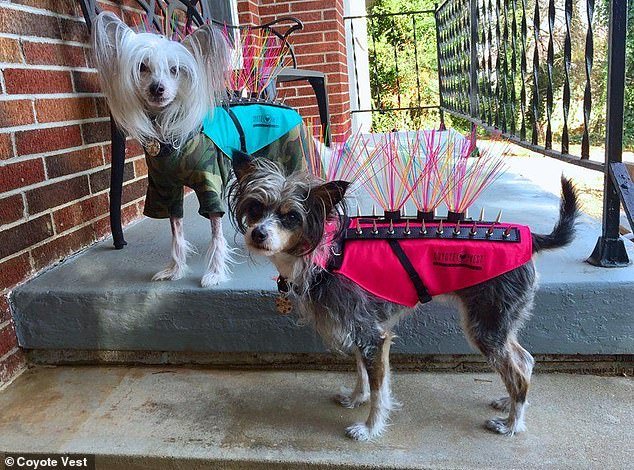Worried pet owners are buying spiked body armor for their beloved dogs and cats to try and stop them being seized and eaten by America’s booming bald eagle population.
The return of the bald eagle population is cause for celebration for conservationists.
But it has come at a cost for people with small pets, who fear their furry friend could become an eagle’s next meal.
Alaskan pet owners who are trying to protect their pups from the state’s estimated 30,000 bald eagles are taking precautions and arming their small dogs with spiky armor.
Mark Robokoff, owner of AK Bark pet shop in Anchorage, is selling a protective jacket called the ‘CoyoteVest,’ which were initially intended to protect small pets form coyotes.
The CayoteVest (pictured) is topped with bright red nylon whiskers that is meant to scare off birds from above
But with booming numbers of the birds in Alaska, Robokoff saw an opportunity to market the vest for pet owners trying to keep their small pups safe, The Wall Street Journal reported.
The vest, covered in bulletproof Kevlar and spikes, is topped with bright red nylon whiskers that Robokoff says scare off the birds from above.
‘Eagles are strong enough to carry a 12-pound salmon, so a four-pound dog is nothing,’ he told WSJ.
The North American bird, with an up to eight-foot wingspan, has come off the endangered species list after successful conservation efforts.

The Bald eagle (pictured) has come off the endangered species list after successful conservation efforts
Once a rare sight, the bald eagle is now a fixture in small towns across North America.
But the birds have left a less than favorable impression with some residents.
The predatorial bird has taken to hunting geese and chickens, with their skill at doing so alarming owners of similarly-sized cats and dogs.
In British Columbia, Jeanine Pesce, who owns a consulting agency, says she and her five-year-old daughter witnessed the bird preparing its meal.
‘One day I watched an eagle drag a Canadian goose back and forth across rocks for hours,’ she told WSJ. ‘I was told that’s how they tenderize their meat.’
Tom Abraham, a British Columbia-based trip planner told WSJ he has had to worry about bald eagles stalking his lambs and his daughter’s chickens.
‘We lost one (chicken) to an eagle last year,’ he told WSJ. ‘I string flags overhead to create an obstacle. It gives the chickens more time to take cover.’
The birds are also messy, leaving poo everywhere they go, WSJ reported.

Initially meant to protect small dogs from cayotes, the CayoteVest (pictured) is covered in Kevlar and spikes

Pet owners are attempting to protect their small dogs from the rising bald eagle population in North America with dog armor
Conservation efforts, including the banning of chemicals like DDT, have allowed for America’s national bird to be removed from the endangered species list in 2007.
A recent report from the U.S. Fish and Wildlife Department found that numbers have quadrupled to more than 316,000 in 2019, from 72,000 in 2009, WSJ reported.
But that only reflects the population in the lower 48, Myles Lamont, a biologist with the Hancock Wildlife Foundation, a nonprofit in Surrey, British Columbia, that promotes the conservation of wildlife, particularly the bald eagle, and its habitat, said.
‘If you factor in the populations in Alaska and Canada you add at least another 150,000 or more birds,’ Lamont told WSJ.
